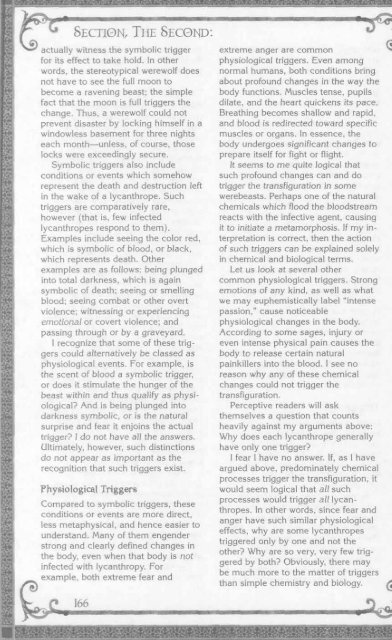Van Richten's Monster Hunter's.pdf - Askadesign.com
Van Richten's Monster Hunter's.pdf - Askadesign.com
Van Richten's Monster Hunter's.pdf - Askadesign.com
Create successful ePaper yourself
Turn your PDF publications into a flip-book with our unique Google optimized e-Paper software.
actually witness the symbolic trigger<br />
for its effect to take hold. In other<br />
words, the stereotypical werewolf does<br />
not have to see the full moon to<br />
be<strong>com</strong>e a ravening beast: the simple<br />
fact that the moon is full triggers the<br />
change. Thus, a werewolf could not<br />
prevent disaster by locking himself in a<br />
windowless basement for three nights<br />
each month-unless, of course, those<br />
locks were exceedingly secure.<br />
Symbolic triggers also include<br />
conditions or events which somehow<br />
represent the death and destruction left<br />
in the wake of a lycanthrope. Such<br />
triggers are <strong>com</strong>paratively rare,<br />
however (that is, few infected<br />
lycanthropes respond to them).<br />
Examples include seeing the color red,<br />
which is symbolic of blood, or black,<br />
which represents death. Other<br />
examples are as follows: being plunged<br />
into total darkness, which is again<br />
symbolic of death: seeing or smelling<br />
blood: seeing <strong>com</strong>bat or other overt<br />
violence: witnessing or experiencing<br />
emotional or covert violence; and<br />
passing through or by a graveyard.<br />
I recognize that some of these trig-<br />
gers could alternatively be classed as<br />
physiological events. For example, is<br />
the scent of blood a symbolic trigger,<br />
or does it stimulate the hunger of the<br />
beast within and thus qualify as physi-<br />
ological? And is being plunged into<br />
darkness symbolic, or is the natural<br />
surprise and fear it enjoins the actual<br />
trigger? I do not have all the answers.<br />
Ultimately, however, such distinctions<br />
do not appear as important as the<br />
recognition that such triggers exist.<br />
Compared to symbolic triggers, these<br />
conditions or events are more direct,<br />
less metaphysical, and hence easier to<br />
understand. Many of them engender<br />
strong and clearly defined changes in<br />
the body, even when that body is not<br />
infected with lycanthropy. For<br />
example, both extreme fear and<br />
extreme anger are <strong>com</strong>mon<br />
physiological triggers. Even among<br />
normal humans, both conditions bring<br />
about profound changes in the way the<br />
body functions. Muscles tense, pupils<br />
dilate, and the heart quickens its pace.<br />
Breathing be<strong>com</strong>es shallow and rapid,<br />
and blood is redirected toward specific<br />
muscles or organs. In essence, the<br />
body undergoes significant changes to<br />
prepare itself for fight or flight.<br />
It seems to me quite logical that<br />
such profound changes can and do<br />
trigger the transfiguration in some<br />
werebeasts. Perhaps one of the natural<br />
chemicals which Rood the bloodstream<br />
reacts with the infective agent, causing<br />
it to initiate a metamorphosis. If my in-<br />
terpretation is correct, then the action<br />
of such triggers can be explained solely<br />
in chemical and biological terms.<br />
Let us look at several other<br />
<strong>com</strong>mon physiological triggers. Strong<br />
emotions of any kind, as well as what<br />
we may euphemistically label "intense<br />
passion," cause noticeable<br />
physiological changes in the body.<br />
According to some sages, injury or<br />
even intense physical pain causes the<br />
body to release certain natural<br />
painkillers into the blood. I see no<br />
reason why any of these chemical<br />
changes could not trigger the<br />
transfiguration.<br />
Perceptive readers will ask<br />
themselves a question that counts<br />
heavily against my arguments above:<br />
Why does each lycanthrope generally<br />
have only one trigger?<br />
I fear I have no answer. If, as I have<br />
argued above, predominately chemical<br />
processes trigger the transfiguration, it<br />
would seem logical that all such<br />
processes would trigger all lycan-<br />
thropes. In other words, since fear and<br />
anger have such similar physiological<br />
effects, why are some lycanthropes<br />
triggered only by one and not the<br />
other? Why are so very, very few trig-<br />
gered IJY both? Obviously, there may<br />
be much more to the matter of triggers<br />
than simple chemistry and biology.


